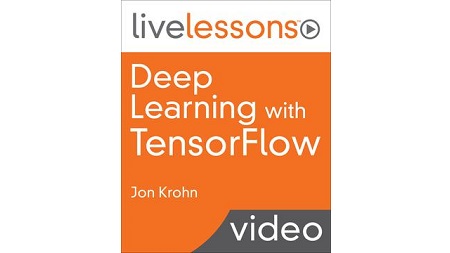
English | MP4 | AVC 1280×720 | AAC 44KHz 2ch | 6h 36m | 2.63 GB
Deep Learning with TensorFlow LiveLessons is an introduction to Deep Learning that bring the revolutionary machine-learning approach to life with interactive demos from the most popular Deep Learning library, TensorFlow, and its high-level API, Keras. Essential theory is whiteboarded to provide an intuitive understanding of Deep Learning’s underlying foundations, i.e., artificial neural networks. Paired with tips for overcoming common pitfalls and hands-on code run-throughs provided in Python-based Jupyter notebooks, this foundational knowledge empowers individuals with no previous understanding of neural networks to build powerful state-of-the-art Deep Learning models.
Learn How To
- Build Deep Learning models in TensorFlow and Keras
- Interpret the results of Deep Learning models
- Troubleshoot and improve Deep Learning models
- Understand the language and fundamentals of artificial neural networks
- Build your own Deep Learning project
Table of Contents
01 Deep Learning with TensorFlow – Introduction
02 Topics
03 1.1 Neural Networks and Deep Learning
04 1.2 Running the Code in These LiveLessons
05 1.3 An Introductory Artificial Neural Network
06 Topics
07 2.1 The Families of Deep Neural Nets and their Applications
08 2.2 Essential Theory I-Neural Units
09 2.3 Essential Theory II-Cost Functions, Gradient Descent, and Backpropagation
10 2.4 TensorFlow Playground-Visualizing a Deep Net in Action
11 2.5 Data Sets for Deep Learning
12 2.6 Applying Deep Net Theory to Code I
13 Topics
14 3.1 Essential Theory III-Mini-Batches, Unstable Gradients, and Avoiding Overfitting
15 3.2 Applying Deep Net Theory to Code II
16 3.3 Introduction to Convolutional Neural Networks for Visual Recognition
17 3.4 Classic ConvNet Architectures-LeNet-5
18 3.5 Classic ConvNet Architectures-AlexNet and VGGNet
19 3.6 TensorBoard and the Interpretation of Model Outputs
20 Topics
21 4.1 Comparison of the Leading Deep Learning Libraries
22 4.2 Introduction to TensorFlow
23 4.3 Fitting Models in TensorFlow
24 4.4 Dense Nets in TensorFlow
25 4.5 Deep Convolutional Nets in TensorFlow
26 Topics
27 5.1 Improving Performance and Tuning Hyperparameters
28 5.2 How to Build Your Own Deep Learning Project
29 5.3 Resources for Self-Study
30 Deep Learning with TensorFlow – Summary
Resolve the captcha to access the links!